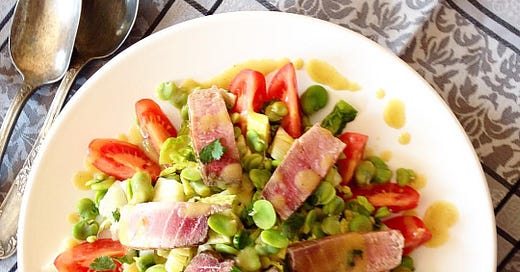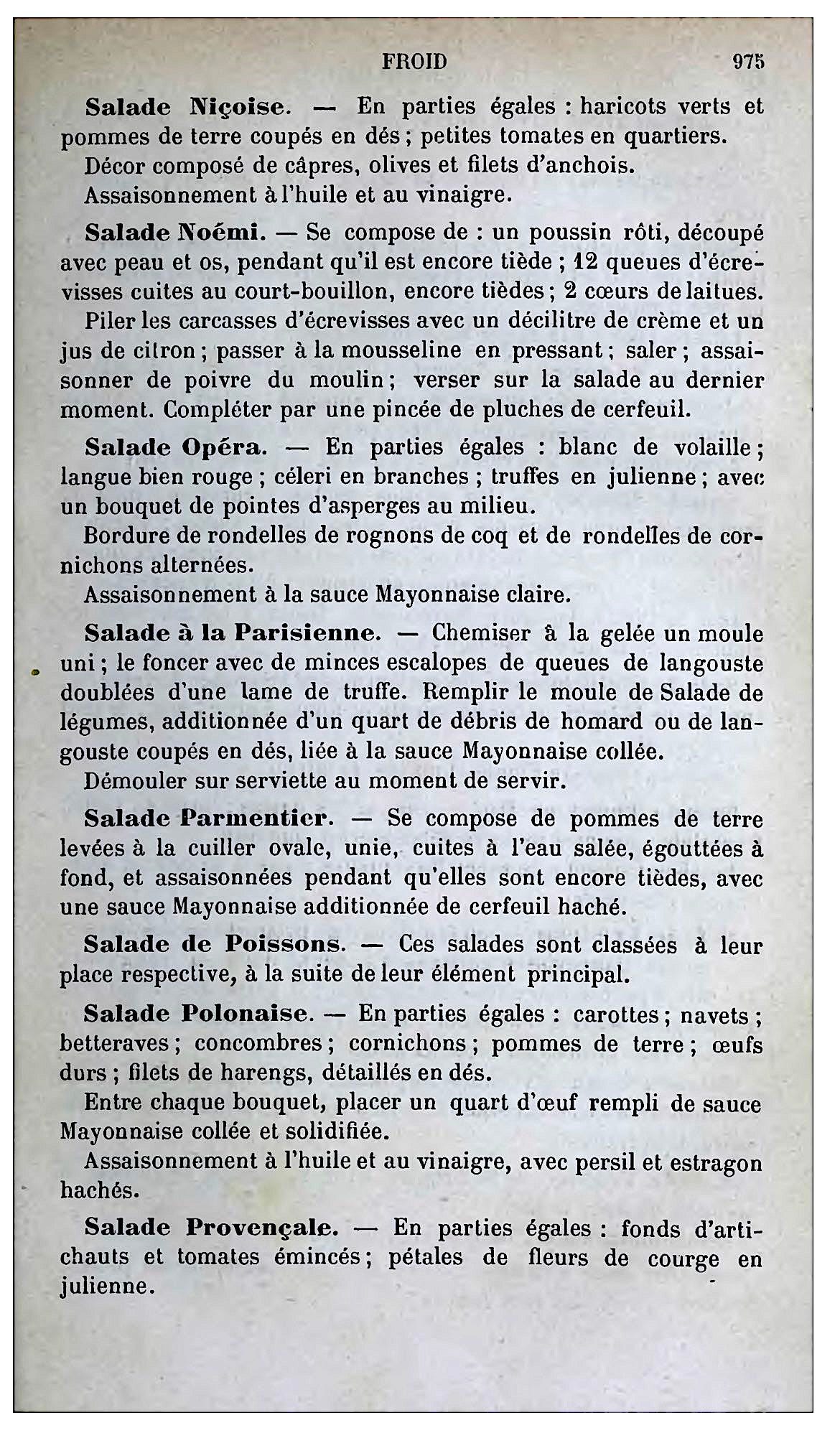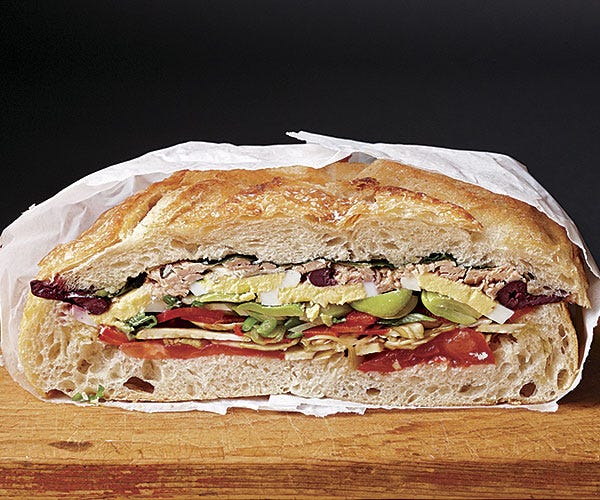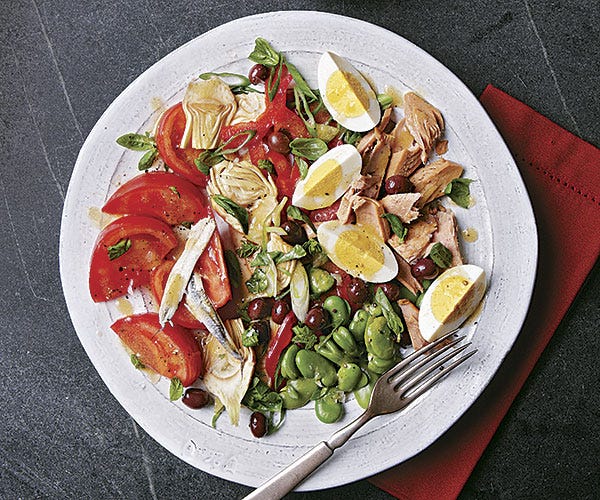In the hands of an able cook, fish can become an inexhaustible source of perpetual delight. - Jean Anthelme Brillat-Savarin
I’m betting that any vacationing American arriving in Paris at the height of summer will quickly find themselves sitting at one of those tiny tables on a café terrace around noon, facing the flow of pedestrian traffic, taking in that very French spectacle, and ordering a big, bright, cool salade niçoise. I know I did all those years ago when I first arrived in the City of Light. A salade niçoise was one of the first truly memorable dishes I ate. Iconic bistro fare, the salade niçoise is a summer classic, a plate piled high with fresh garden vegetables, salty black olives, anchovies or tuna (or both), encircled by wedges of hard-boiled egg, and drizzled with olive oil or a mustardy vinaigrette. The salade niçoise is a satisfying, wonderfully refreshing and healthy meal and it quickly became a favorite. It wasn’t until years later, long settled in France, that I learned the differences between what made up a true salade niçoise and what is served in most Parisian restaurants.
While steamed green beans or boiled potatoes, even rice have found their unlikely way into Parisian… and American… versions, the traditional and authentic salade niçoise contains only raw vegetables, straight from the garden or market, of course - tomatoes, fava beans, bell peppers, artichokes, spring onions - the hard-boiled eggs being the only cooked ingredient other than the anchovies or lightly grilled fish. And tiny, sharply flavorful black niçoise olives, marking this salad as something truly Mediterranean. And a classic salade niçoise is layered, never tossed. As this is served as a main course, it is always served abundantly.
But this elegant dish wasn’t always so. As with so many dishes that seem, to our contemporary minds and palates, to be a sophisticated blend of premium ingredients, the salade niçoise, originating in the southern port city of Nice, began its relatively short life as an uncomplicated poor man’s dish eaten by the local fisherman or workers. This simple meal was originally made up of tomatoes thickly sliced, lightly salted and drizzled with olive oil, the traditional fat used for cooking in the south of France, and topped with anchovies, freshly and abundantly fished and cheap. I referred to its “relatively short life" because tomatoes weren’t considered an edible culinary item in France until the middle of the 18th century, although immediately becoming popular and widely cultivated across the Mediterranean coastal regions so therefore most probably cheap. Like today, anyone with a plot of soil and sunshine could grow tomatoes.
It’s possible that the first appearance of salade niçoise in a cookbook was Auguste Escoffier’s 1903 Le Guide Culinaire: aide-mémoire de cuisine pratique, a manual of recipes and instructions for the use of professional chefs, kitchen staff, and culinary students. His version is a rather bastardized version of the traditional salad, beginning with cooked and diced green beans and potatoes, quartered tomatoes, capers, olives, and anchovy filets seasoned and drizzled with olive oil. The 1912 edition has the addition of vinegar flavoring the salad along with the olive oil.
By the 19th century, with the development of agriculture, other ingredients did begin finding their way into the salad, red or spring onions, bell peppers, and fava beans - or more precisely févettes, which are young and tender and can indeed be eaten raw, like the rest of the traditional ingredients in the dish. Tuna - a luxury back in those days - and hard boiled eggs were added much later. Very thinly sliced purple artichoke known as Violet de Provence, sliced so thinly as to allow them to easily be eaten raw, was another local ingredient that found its way into this summer provençale dish.
Pan Bagnat, niçoise dialect for the French pain baigné or mouillé, bathed or wet bread, is the traditional sandwich version of the niçoise salad, a carry-along meal for fishermen or those working in the fields. A round, crusty bread roll is sliced almost but not quite through the center (leaving the two halves attached on one side, a way to catch the filling from falling out). The inside halves of the roll are rubbed with a crushed garlic clove, which is then discarded, and then “bathed” - drizzled or spooned - with olive oil, allowing the oil to soak into the bread and softening it. Slices of ripe tomato, hard-boiled eggs, thin strips of green or red bell pepper, red or spring onion or even radishes are all layered into the roll. Sliced, pitted black olives and a couple of anchovy filets or some sliced or crumbled tuna are then stuffed into the bread on top of the vegetables. More olive oil is then drizzled on.. add some vinegar or the mustardy vinaigrette and a few basil leaves if you like… then the roll is closed and pressed tightly. The Pan Bagnat is always prepared in advance to allow the ingredients to marinate, the bread to moisten, and the flavors to blend. Now just wrap it up tightly and carry it along to work or picnic.
Salade Niçoise
This story and recipe were originally written for and published in the Aug/Sep 2016 issue of Fine Cooking magazine. I have updated the story.
Serves 6
Notes: Fresh tuna is commonly replaced with high-quality, oil-packed canned tuna or why not switch out both the anchovies and the tuna for grilled sardines or red mullet, both Mediterranean fish.
Fresh favettes or young, tender, fava or broad beans, which are eaten raw, are traditional in Nice for this salad, but if only the more mature beans are available, simply drop the shelled beans into boiling salted water and cook for not more than one minute; drain the beans and quickly cool under running water then slip the beans out of the outer skins, discarding the skins. Frozen fava beans can also be used, just follow the cooking directions on the package.
4 - 6 eggs
1 inch-thick slice fresh tuna, about 7 ounces, or 1 can high-quality oil-packed canned tuna
8 - 10 ripe but firm tomatoes
4 spring onions, scallions, or small radishes
1 green or red bell pepper
4 small violet artichokes, violet de provence or poivrade
1 clove garlic, peeled and halved
1 ½ cups shelled fresh tender, early broad beans or fava beans, the bean slipped out of the thin skin that may cover it, from about 2 pounds pods (see notes above)
1 cup unpitted black olives, preferably small Niçoise olives or Greek olives
6 oil-packed anchovy filets
Salt and pepper
8 - 10 tender basil leaves
Best-quality extra-virgin olive oil + 1 lemon or red wine vinegar or Mustard Vinaigrette (recipe below)
Fill a saucepan big enough to hold all of the eggs in one layer with enough water to just cover the eggs. Bring the water to a rolling boil and carefully slip the eggs into the water. Reduce slightly to a low boil and cook the eggs for 10-12 minutes, depending on how well boiled you like them. Immediately transfer the eggs to a colander and run them under cold water until cool enough to handle. Peel the eggs under cold running water and set aside.
If using fresh tuna, pat the fish dry on both sides while you heat up a grill or skillet. Brush one side of the tuna with olive oil then lightly salt and pepper; when the skillet is very hot, place the tuna oiled side down on the grill and cook for 3 minutes. While the first side of the tuna cooks, brush the top side with olive oil and dust lightly with salt and pepper. Carefully flip the fish over and cook for another 3 minutes. Lift the tuna onto a plate or cutting surface and cut into thin slices.
Rinse and pat dry the tomatoes and cut each into 8 wedges from top to bottom along the core, cutting out and discarding any hard core. Place the tomato wedges in a large colander and dust with salt, a couple of pinches or about ½ teaspoon. Leave the tomatoes to drain of their excess water the time it takes to prepare the rest of the ingredients.
Trim and thinly slice the spring onions, both the white bulb and the pale greens, or trim and very thinly slice the radishes. Remove and discard the stem from the bell pepper, slice in half lengthwise and cut out and discard the white ribs and the seeds. Slice each bell pepper half into thin strips.
Remove and discard the tough outer leaves of 4 artichokes. Slice off the top point of each artichoke, about half an inch, and then cut off the stem. Using a sharp paring knife, pare down and trim off the tough outer covering of the base until you are left with only the tender base and leave of the artichokes. Slice each artichoke in half lengthwise down the center and cut or scoop out any fuzzy choke. Very thinly slice the artichokes.
Slice the clove of garlic in half lengthwise and rub the serving platter generously with the garlic to perfume the dish; discard the clove. Arrange the tomato wedges in a circular pattern on the platter followed by the artichoke slices, green pepper, the spring onions or radishes, and finally the beans. Slice the eggs from top to bottom into four wedges and place the wedges around the tomatoes.
Distribute the olives and drape the anchovies across the top of the salad. If using fresh grilled tuna, slice in thin strips and place the strips between and around the anchovies; if adding canned tuna, separate the fish into chunks and arrange on the salad.
Lightly salt the salad and add a couple of grindings of black peppers. Drizzle the olive oil and either lemon juice or a tablespoon or two of red wine vinegar over the salad; alternately drizzle with a good vinaigrette (recipe below). Rip or snip the basil leaves into pieces and scatter over the salad.
Carry the platter to the table and serve, placing extra olive oil and vinegar or vinaigrette on the table. Serve with crusty bread and a good, chilled provençale wine.
Mustard Vinaigrette:
1 ½ teaspoons Dijon-style mustard
2 tablespoons red wine vinegar
Salt and pepper
5 tablespoons high-quality extra-virgin olive oil
Place the mustard in a bowl and add the vinegar, add salt and freshly ground black pepper and whisk until smooth. Continue whisking as you add the olive oil in a slow, steady stream until well blended, smooth, and creamy. Taste and add more mustard, vinegar, salt or pepper as desired.
Thank you for subscribing to my Substack, Life’s a Feast by Jamie Schler, where I share my recipes, mostly French traditional recipes, with their amusing origins, legends, and history. I’m so glad that you’re here. You can support my work by sharing the link to my Substack with your friends, family, and your social media followers. If you would like to see my other book projects in the making, read my other essays, and participate in the discussions, please upgrade to a paid subscription.







I regret to inform you that, because I am an American male of a certain age, I make a niçoise where all the ingredients — except for the eggs — are grilled.
So much yes! What a lovely salad and the picture of it just makes me want to dive in! Also Escoffier’s Salade Noémi sounds a little intimidating... 👀